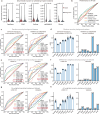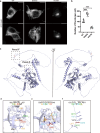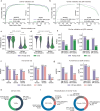Decoding Missense Variants by Incorporating Phase Separation via Machine Learning
- PMID: 39333476
- PMCID: PMC11436885
- DOI: 10.1038/s41467-024-52580-3
Decoding Missense Variants by Incorporating Phase Separation via Machine Learning
Abstract
Computational models have made significant progress in predicting the effect of protein variants. However, deciphering numerous variants of uncertain significance (VUS) located within intrinsically disordered regions (IDRs) remains challenging. To address this issue, we introduce phase separation, which is tightly linked to IDRs, into the investigation of missense variants. Phase separation is vital for multiple physiological processes. By leveraging missense variants that alter phase separation propensity, we develop a machine learning approach named PSMutPred to predict the impact of missense mutations on phase separation. PSMutPred demonstrates robust performance in predicting missense variants that affect natural phase separation. In vitro experiments further underscore its validity. By applying PSMutPred on over 522,000 ClinVar missense variants, it significantly contributes to decoding the pathogenesis of disease variants, especially those in IDRs. Our work provides insights into the understanding of a vast number of VUSs in IDRs, expediting clinical interpretation and diagnosis.
© 2024. The Author(s).
Conflict of interest statement
The authors declare no competing interests.
Figures






Similar articles
-
Deep learning tools predict variants in disordered regions with lower sensitivity.BMC Genomics. 2025 Apr 12;26(1):367. doi: 10.1186/s12864-025-11534-9. BMC Genomics. 2025. PMID: 40221640 Free PMC article.
-
Initial Investigations of Intrinsically Disordered Regions in Inherited Retinal Diseases.Int J Mol Sci. 2023 Jan 5;24(2):1060. doi: 10.3390/ijms24021060. Int J Mol Sci. 2023. PMID: 36674574 Free PMC article.
-
Prediction of phase-separation propensities of disordered proteins from sequence.Proc Natl Acad Sci U S A. 2025 Apr;122(13):e2417920122. doi: 10.1073/pnas.2417920122. Epub 2025 Mar 25. Proc Natl Acad Sci U S A. 2025. PMID: 40131954
-
Phase Separation as a Missing Mechanism for Interpretation of Disease Mutations.Cell. 2020 Dec 23;183(7):1742-1756. doi: 10.1016/j.cell.2020.11.050. Cell. 2020. PMID: 33357399 Review.
-
Towards Decoding the Sequence-Based Grammar Governing the Functions of Intrinsically Disordered Protein Regions.J Mol Biol. 2021 Jun 11;433(12):166724. doi: 10.1016/j.jmb.2020.11.023. Epub 2020 Nov 26. J Mol Biol. 2021. PMID: 33248138 Review.
Cited by
-
Functions of Intrinsically Disordered Regions.Biology (Basel). 2025 Jul 4;14(7):810. doi: 10.3390/biology14070810. Biology (Basel). 2025. PMID: 40723369 Free PMC article. Review.
-
Genomic landscape of childhood acute lymphoblastic leukemia in Malaysia: insights from array-CGH.Mol Cytogenet. 2025 Mar 28;18(1):7. doi: 10.1186/s13039-025-00709-4. Mol Cytogenet. 2025. PMID: 40155977 Free PMC article.
-
Molecular dynamics simulations of intrinsically disordered protein regions enable biophysical interpretation of variant effect predictors.bioRxiv [Preprint]. 2025 May 12:2025.05.07.652723. doi: 10.1101/2025.05.07.652723. bioRxiv. 2025. PMID: 40462930 Free PMC article. Preprint.
References
-
- Alberti, S. Phase separation in biology. Curr. Biol.27, R1097–R1102 (2017). - PubMed
Publication types
MeSH terms
Substances
LinkOut - more resources
Full Text Sources

